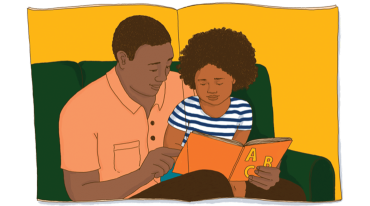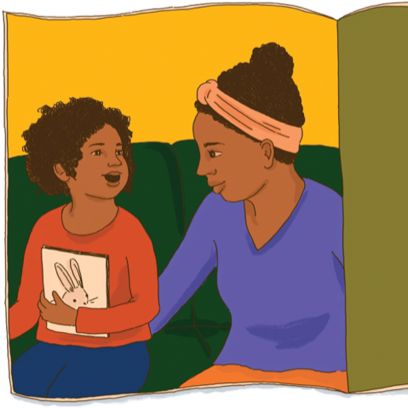Reading is arguably the most important skill that children learn in school—and yet many children struggle to become strong readers.1 This is especially true of African American children. Children growing up in low-income, under-resourced neighborhoods often struggle with reading. But even among Black children in wealthier neighborhoods, learning to read can be a challenge. Recent results from the National Assessment of Educational Progress show that fewer than 20 percent of African American fourth-graders are strong readers and more than 50 percent are struggling with reading.2
In this article, we are sounding the alarm to African American families! If your child is struggling to learn to read, there are many things that you can do at home to support them.* The questions we hope to address here are: (1) What’s most important for African American children to become strong readers? and (2) What can you do to help your child?
What’s Most Important for African American Children to Become Strong Readers?
Throughout this issue of American Educator, we see that lots of things are essential for helping children learn to read, from developing their oral language and vocabulary to helping them hear the sounds that make up words to showing them how letters represent sounds. That’s all true for African American children too. But research suggests that there are three factors that have the most influence on reading growth for African American children: language, access to reading materials, and practice reading.
Language
Reading is not just about recognizing words on a page. Reading relies heavily on oral language (speaking) skills. Research has shown that many African American children come to school using African American English (AAE), which is an oral language variety that differs in important ways from the print that they will see in books.3 AAE is used by many African American children and adults in their families and communities. AAE influences learning to read, write, and spell, especially for children who use a lot of AAE when they talk. For these children, there will be many instances when text does not match their oral language. When these mismatches are present, children may need to take more time to resolve these differences between the way they talk and what they are trying to read. Resolving these differences can slow children down, contributing to their struggle to develop strong reading skills. The good news is that strength in any oral language variety—including AAE—can support strong reading skills. But children will need more time, exposure to text, and practice reading to do their best. If you do not have many books at home, you can ask your child’s teacher to send more books home for your child.
Books are written in General American English (GAE), not AAE. Reading will become easier as children continue to read, recognize, analyze, and resolve the differences that they encounter between their speech and text. For example, there are sound differences between GAE and AAE. The child who speaks AAE may say goal and gold the same way because dropping the last sound in a word is common in AAE. There are also differences in sentences between GAE and AAE. An AAE-speaking child may say, “The boy be runnin_ home from school to go to his frien_ house to watch his favorite show.” In text, the same idea may be written as “The boy runs home from school each day to watch his favorite show at his friend’s house.” The two sentences use different words and word orders, but they are both complex sentences that mean the same thing. The more children read, the more they will encounter the second sentence, supporting their ability to make connections between the way they say the sentence and how it appears in books.
Access to Reading Materials
This analysis process is supported when African American children have enough opportunities to read. Reading daily and reading many different kinds of books provides valuable exposure to the language of texts. If a child does not have many books at home or does not have access to books, both their language and their literacy development can be impacted. In this case, difficulty with reading may not just be about learning to connect oral AAE and text GAE, but about access to print combined with language differences. It is important for any child who uses an oral language that is different from print (including Spanish, Appalachian English, and other languages and varieties of English) to have strong reading instruction that is sensitive to these differences and more opportunities to read books.
In today’s digital age, access to technology and digital resources is increasingly important for reading development. Online libraries, e-books, educational websites, and interactive reading platforms all provide opportunities for engaging with text. It is also important to consider the content of the books you choose because representation matters in reading materials. Your child will benefit from seeing characters, stories, and experiences that reflect their own cultural background, identities, and interests.
Practice Reading
Parents and caregivers can provide lots of opportunities for children to practice reading at home. You can read together, and your child should also read silently on their own. Encourage your child to read aloud to you or to younger siblings. Reading aloud helps improve pronunciation, comprehension, and fluency (i.e., reading quickly, smoothly, and accurately). It also provides an opportunity for you to listen and offer guidance or support when needed.
While you are reading books, be sure to talk about them. Talking about what has been read is an important way for you to help your child make connections to what is in the book—and a great way for you to find out if your child understands the book. This is especially important for children who are using AAE when they talk! Conversations between you and your child will help them better understand the meaning of the books that you are reading together and that they read on their own. Books about topics of high interest or about experiences that your child recognizes will also increase comprehension and motivation to continue reading practice.
What Can You Do to Help Your Child?
The good news is that with proper instruction and practice, most children will learn to read. But it can be painful to listen to your child struggle to read words, especially when you think they should be reading better than they are. Most parents and caregivers want to know, “What can I do at home to help my child become a better reader?”
We know that you are not reading teachers, and we don’t expect you to be. But you can help your child become a better reader and enjoy reading. You don’t need any complicated strategies. Most importantly, remember that all children benefit from as much experience with print as you can provide. Here are several simple things that you can do.
- Get to know your child’s teachers and be sure they know how to teach children who use AAE. If they don’t, here’s an article you can share with them: “Teaching Reading to African American Children: When Home and School Language Differ.” It’s available for free here.
- Set aside a few minutes a day to read with your child. You can be the reader, your child can read to you, or you can take turns reading.
- Talk about the books you are reading together. Having conversations about books will help your child understand the text better and will help develop their reading comprehension skills. Conversations in AAE are helpful and affirming. You do not need to change the way you talk! Just talk.
- Play word games and sing songs that bring attention to the sounds in words—this can be fun! Many of the games that we played as children were really word games that helped us with rhyming and wordplay. Do you remember Red Rover, Red Light/Green Light, the Name Game, and Mary Mack? Teaching your child to play these games (and others that you loved as a child) helps develop their listening comprehension (i.e., understanding when someone is speaking or reading to them). These games also foster flexibility with the sounds in words, which helps with reading. For example, once your child can sound out cat, they will more easily read hat, mat, and pat. We were all learning while we were playing!
- Ask your child what they would like to read about. If you choose topics that your child loves, their motivation to read will increase.
- Show your child that you value reading. Let them see you regularly reading things that you enjoy and talk about what you learn. Modeling reading is one of the most important things you can do to help your child become a strong reader.
Julie A. Washington is a professor in the School of Education at the University of California, Irvine. A speech-language pathologist and fellow of the American Speech-Language-Hearing Association, she directs the Learning Disabilities Innovation Hubs and the Language Variation and Academic Success lab. Gennie R. Laramore is a speech-language pathologist and a doctoral student in the School of Education at the University of California, Irvine.
*For a longer version of this article written for educators, see “Teaching Reading to African American Children” in the Summer 2021 issue of American Educator. (return to article)
Endnotes
1. J. Chall, V. Jacobs, and L. Baldwin, The Reading Crisis: Why Poor Children Fall Behind (Cambridge, MA: Harvard University Press, 1990); D. Goldstein, “It’s ‘Alarming’: Children Are Severely Behind in Reading,” New York Times, March 8, 2022; and S. Mervosh, “A ‘Science of Reading’ Revolt Takes on the Education Establishment,” New York Times, April 18, 2023.
2. National Assessment of Educational Progress, “NAEP Report Card: Reading; National Achievement-Level Results,” nationsreportcard.gov/reading/nation/achievement/?grade=4.
3. H. Craig and J. Washington, “Oral Language Expectations for African American Preschoolers and Kindergartners,” American Journal of Speech-Language Pathology 11, no. 1 (2002): 59–70; J. Washington and H. Craig, “Morphosyntactic Forms of African American English Used by Young Children and Their Caregivers,” Applied Psycholinguistics 23, no. 2 (2002): 209–31; and C. Connor and H. Craig, “African American Preschoolers’ Language, Emergent Literacy Skills, and Use of African American English: A Complex Relation,” Journal of Speech, Language, and Hearing Research 49, no. 4 (2006): 771–92.
[illustrations: Mia Nolting]


